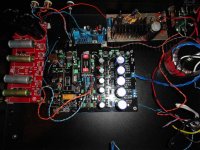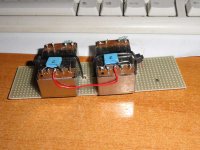Entirerly
PRETTY meaningless on paper is not ENTIRELY meaningless on paper or in practice. Take your circuit exactly as it is and add another 100R on each leg of the output, after everything else. Listen with them in and out. You will hear a slight loss of micro dynamics and transparency from them. Just as there is from the first pair in the filter. Is the filter a slight necessary evil. Maybe. Maybe not so necessary with these modern V out dacs. One idea I had would be to move the shunt cap of the ultrasonic filter to the secondary side so as to take advantage of the free series resistance of the transformer windings in order to reduce the series resistors down to the minimum that is required to control any ringing.Also, the 100 ohm series resistance added to the dac chip is pretty meaningless to the input of a preamp which has a normal input impedance of thousands of ohms.
Also, the 100 ohm series resistance added to the dac chip is pretty meaningless to the input of a preamp which has a normal input impedance of thousands of ohms.
Bill, perhaps you can dig me out of my confusion.
I thought the resistance in series (not the resistance to ground) with each leg of the DAC output was required so the next component upstream would not try to draw current from the source (DAC, since DAC chips are not designed to provide much current).
The pre-amp (more specifically the volume pot on the pre-amp) is providing a resistance to ground not a series resistance. Is my confusion "clear" (insert smiley face here...)
Look at it this way. If you place your volume pot at the mid way point, the resistance above the wiper is in series with the source, and the rest of it is shunting part of the signal to ground. Adding additional resistance in series is merely changing the value of the voltage divider function. In other words, the series resistance is always going to end up as part of the load. Draw yourself a little schematic of a source feeding a preamp volume pot and you'll get it.
Sendler's point would be valid only if you could eliminate all resistors in the signal path. I guess you could do it with a multi tapped volume trafo, but I can't afford them.
Sendler's point would be valid only if you could eliminate all resistors in the signal path. I guess you could do it with a multi tapped volume trafo, but I can't afford them.
Interconnects
Don't forget you have interconnects between the increased output impedance of the source and the pot. It is really just a nit pick any way but I just wanted to raise the concept that there are other mechanisms at work as to the audibility of the filter other than just the roll off at 150KHz. My system is a little more sensitive to source output impedance with 8 foot interconnects into 4k stepped attenuators.Adding additional resistance in series is merely changing the value of the voltage divider function. In other words, the series resistance is always going to end up as part of the load.
Jensen JT-11-FMCF vs EMCF
I did some listening today between my Jensen JT-11-FMCF and EMCF as configured for balanced to single ended direct out from the CS43122 and AK4395 dac chips. The extra headroom of the larger EM is readily apparent in the crack and slam of the cymbals during the intro to No God from the Extreme, Waiting for the Punchline disc. Darn it. The $66 trannie sounds better than the $50. I was hoping that the maximum levels of the chips wouldn't challenge the capacities of the FMCF or something even smaller and cheaper. Now I am intrigued to try something even better.
I did some listening today between my Jensen JT-11-FMCF and EMCF as configured for balanced to single ended direct out from the CS43122 and AK4395 dac chips. The extra headroom of the larger EM is readily apparent in the crack and slam of the cymbals during the intro to No God from the Extreme, Waiting for the Punchline disc. Darn it. The $66 trannie sounds better than the $50. I was hoping that the maximum levels of the chips wouldn't challenge the capacities of the FMCF or something even smaller and cheaper. Now I am intrigued to try something even better.
I did some listening today between my Jensen JT-11-FMCF and EMCF as configured for balanced to single ended direct out from the CS43122 and AK4395 dac chips. The extra headroom of the larger EM is readily apparent in the crack and slam of the cymbals during the intro to No God from the Extreme, Waiting for the Punchline disc. Darn it. The $66 trannie sounds better than the $50. I was hoping that the maximum levels of the chips wouldn't challenge the capacities of the FMCF or something even smaller and cheaper. Now I am intrigued to try something even better.
I dream fitting an AK4396 on this chinese board.
CS chips better
The CS dac chips sound better than the AKM. At this point, unless an exotic I/V stage is used, in my experience a direct out CS chip will also sound better than the PCM chips even though they have a huge cult following. I have had PCM63, PCM1704, and now tried a quickie I/V with the PCM1798 and none have rivaled the transparency of the CS43122.I dream fitting an AK4396 on this chinese board.
Couldn't float
Ps. I tried to leave the single ended ground floating but had a hum so I had to connect one leg of the secondary to the dac ground.
I did some listening today between my Jensen JT-11-FMCF and EMCF as configured for balanced to single ended direct out from the CS43122 and AK4395 dac chips.
Ps. I tried to leave the single ended ground floating but had a hum so I had to connect one leg of the secondary to the dac ground.
LL1684
I might try the LL1684 someday.For those who are interested
I will sell one of my two pairs of Lundahl LL1690 for $175. Ther're just 'broken in' so you'll not have to do it. It takes at least 100 hours to settle.
This is a very long thread with very much information, so I have not read it all. I am going to build a DAC, probably the Gigawork DAC with some modifications(since it seems it is much to gain with some modifications). What is the best modifications to do?
I am going to connect my cd player using the coax connectionand my computer using the USB, I think.
Had been really great with some tips on the best modifications to do, before I start to build everything.
I am going to connect my cd player using the coax connectionand my computer using the USB, I think.
Had been really great with some tips on the best modifications to do, before I start to build everything.
you will not get very far around here asking what 'the best' is. you can get choices and info to help you narrow it down, but nobody is going to be able to agree what 'the best' is, because its different for everyone with their ears and their equipment. so narrow it down and then build to see, maybe you wont get it perfect first time, but you will learn what you like or dont like; nobody else can do that for you
Okay, I understand. The thing is that I am not very good at the technical part of digital electronics. I have been building some speakers and modding some tube amplifiers, but not any digital stuff. So I am just trying to get some ideas of what is good and what may not be good. I am looking for a DAC that can deliver a good musical and detailed presentation. At this time I am in the in the planning stage, and are trying to plan how I am going to build this from the start so I dont have to rebuild "everything" later.
- Home
- Source & Line
- Digital Line Level
- Experience with this DIY DAC ?

